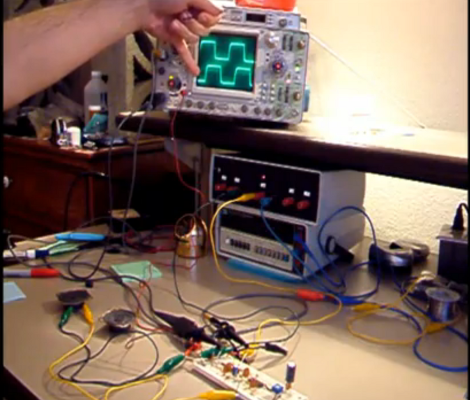
[Kenneth Finnegan] put up a lengthy primer on PLLs (Phase-Locked Loops). We really enjoyed his presentation (even the part where he panders to Rigol for a free scope… sign us up for one of those too). The concepts behind a PLL are not hard to understand, and [Kenneth] managed to come up with a handful of different demonstrations that really help to drive each point home.
A PLL is made up of three parts: a phase detector, a low pass filter, and a voltage controlled oscillator. It can do really neat things, like multiply clock speed (you see them in beefier chips like the ARM architecture all the time). The experiments seen in the video use a CD4046 chip which has two different types of phase detectors. The two signals displayed on the oscilloscope above compare the incoming clock signal with the output from the VCO. Depending on the type of phase detector used, and the quality of the low-pass filter, these might be tightly synchronized or wildly unstable. Find out why by watching the video embedded after the break.
[youtube=http://www.youtube.com/watch?v=0jzLDe950AY&w=470]
















Great stuff ! thanks :)
This could not have come at a better time. Working on clock stuff at work and I had no idea how PLLS were (or WHAT they were until I wikipedia’d it)
Very good tutorial.
Many thanks for all that work :)
Very interesting tutorial. I had classes on this in undergrad, never understood it until now.
Thanks!
“Phase jump Operational, entering slip space drive”…. Sorry, had to say it.
(sins of a solar empire)
Very informative. Someone actualy explaining how things work, not repeating how someone says it works.
Well done. This guy is more informative than Dave Jones, but Jones is very entertaining, even though he doesnt always know what hes talking about.
I seems to recall there being a similar video on the subject before.
Thanks for all the positive feedback everyone! I think Dave Jones also did a video on PLLs back in the day.
I will always give Dave the credit he deserves. Just putting this single video together was several days of research and work; I can’t believe what some of his videos take.
Jerri elsworth did one with a guy that made the c64 or amiga I think
Yeah just search for bil herd and jerri elsworth and you will find it he was a guy who did alot of the work on the c64 128 ect
Yep; that’s the video I was thinking of. Disregard my last comment.
My favorite use for a PLL is to maintain resonance in a series resonant circuit. This is useful in induction heaters because as the metal in the coil heats up, it’s magnetic properties change. it passes a point (the Currie point), where the properties change drastically and rapidly such that the inductance changes as well. The frequency of the energizing wave is altered to maintain resonance.
See here: http://uzzors2k.4hv.org/index.php?page=ihpll1
There is something about harnessing energy to efficiently melt steel that is so appealing.
Horowitz AND HILL.
But other than that, great stuff! Thanks!
I need to re-watch it as well as do some reading on additional reasons WHY you’d want to use a PLL, but this is the first time I’ve had someone explain a PLL in a way I can understand. I’ve checked out several videos including the one w/ Jerri, read the Wikipedia article and more, but none have made sense to me until this one. Much thanks to you, Kenneth, you’ve gotten me past a hurdle that I’ve been struggling with for a bit now.
Ask, and ye shall receive: http://www.youtube.com/watch?v=LdVxYZqde4E
First of all thx for this useful tutorial.
i am trying to make induction heater using cd4046,but i have a question regarding the cutoff freq,how to determine it? for example if my fmax is 70KHZ and center freq is 60KHZ,and min freq is 50KHZ,what will be the cutoff frequency according to it,i can design my low pass filter, any excel sheet u did?or any formula,plz i need ur help in this issue
i appreciate ur answer.
Best Regards
Alloush
Ken,
Your instructional video on the VCO is the best I found on the internet. I don’t know what you do for a living, but you should be a teacher. Maybe you could do another video on the Schmitt Trigger circuit.
Thanks again,
Roger
Thanks! I’m currently a teaching associate at Cal Poly SLO.